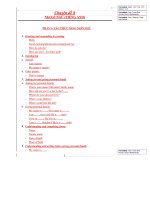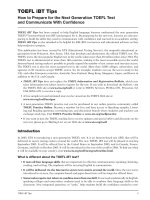chuyen de tag questions
Bạn đang xem bản rút gọn của tài liệu. Xem và tải ngay bản đầy đủ của tài liệu tại đây (138.62 KB, 3 trang )
<span class='text_page_counter'>(1)</span><div class='page_container' data-page=1>
<b>II/ TAG QUESTION:</b>
<b>A tag question is a special construction in English. It is a statement followed by a mini-question. We use tag </b>
<b>questions at the end of statements to ask for confirmation or agreement. They are very common in English.</b>
<i><b>The basic structure is: </b></i>
<b>+</b> <b></b>
<b>-Positive statement,</b> <b>nagative tag?</b>
<b>Ex</b>: Snow is white, isn't it?
Peter helped you, didn't he?
Mary will come, won't she?
The weather should be bad, shouldn't it?
<b>-</b> <b>+</b>
<b>Negative statement</b> <b>positive tag?</b>
<b>Ex</b>
<b> </b>:<b> </b> There wasn’t enough time, was there?
But he can't swim, can he?
We'd never have known, would we?
This won't work, will it?
<i><b>Answers to tag questions:</b></i>
Answer a tag question according to the truth of the situation. Your answer reflects the real facts, not
(necessarily) the question.
<b>Ex: The moon goes around the earth, doesn’t it? ~Yes, it does.</b>
The Asian people don’t like rice, do they? ~Yes, they do.
The English alphabet doesn’t have 40 letters, does it? ~No, it doesn’t.
Snow is black, isn’t it? ~No, it isn’t.
<i><b>Some special cases</b></i><b>:</b><i><b> </b></i>
<b>1)</b> <b> I am right, aren’t I? -> aren’t I ( Ex:</b> <i>not</i> amn’t I)
You have to go, don’t you? -> you (do) have to go…
He’d better do it, hadn’t he? -> he had better (no auxiliary)
<b>2)</b> The statements which contain these words <i><b>neither, no (adjective), none, no one, nobody, nothing, </b></i>
(semi-negative words) <i><b>scarcely, barely, hardly, hardly ever, seldom rarely never </b></i>are used as
negative statements and followed by positive tag.
<b>Ex:</b> No salt is allowed, is it?
<b>Nothing was said, was it?</b>
Peter hardly ever goes to parties, does he?
You rarely go out at midnight, do you?
He met nobody at the corner, did he?
Neither of them could speak English, could they?
<b>3)</b> When <i><b>anyone, nobody, none, neither, something, everyone, someone, etc</b></i> is the subject in the
statement, we use it in the tag to refer to something or nothing and they in the tag to refer to
someone or nobody
<b>Ex:</b>
<b> Everyone warned you, didn’t they?</b>
<b>Someone had recognized him. hadn’t they?</b>
<b>Something happened at Jack’s house, didn’t it?</b>
<b>Neither of them complained, did they?</b>
<b>4)</b> <i>Question tags with imperatives and let’s :</i>
After imperatives, we sometimes add will you?, won’t you?, etc. We use won’t for invitations
and can, can’t, will, would for orders. After let’s we add shall we?
<b>Ex:</b> Don’t stay there long, will you?
Help me, can’t you?
</div>
<span class='text_page_counter'>(2)</span><div class='page_container' data-page=2>
Close the door, would you?
<b>5)</b> <i>Omission of pronoun subject and auxiliary verb:</i>
In very informal speech, we sometimes leave out pronoun subjects, auxiliary verbs and verb to be
in the sentence.
<b>Ex:</b> Awful weather, isn’t it? (= It’s awful weather, isn’t it?)
Keeping well, are you? (= You’re keeping well, aren’t you?)
Nobody at home, is there? (= There’s nobody at home, is there?)
<b>6)</b> <i>Same-way question tags:</i>
We use same-way question tags to express interest, surprise, anger etc,and not to make real question
<b>Ex:</b> <sub></sub>So she’s having a baby, is she? That’s wonderful. (positive-positive structure)
You don’t think that’s amusing, do you? Think again. (positive-positive structure)
Peter doesn’t like my looks, doesn’t he? (negative-negative structure -> rather hostile)
7) <i>Negative Adjectives</i>
He is unhappy, ?
It’s inexpensive. ?
It’s illegal, ?
8) <i>Negative Adverds</i>
He did this incorrectly, ?
The price increases unreasonably, ?
<i><b>Intonation</b></i>:
If we use rising intonation in the tag, we do not know or are not sure what the answer will be. If we use a
falling intonation in the tag, we are simply seeking agreement.
<b>Ex:</b> You haven’t seen my tennis shoes, have you? <i>(<b></b> rising</i>) ~No, I’m sorry. I haven’t.
I couldn’t borrow your dress by any chance, could you? <i>(<b></b> rising</i>) ~No. They wouldn’t fit you.
It’s been a lovely wedding, hasn’t it? <i>(<b></b> falling</i>) ~Wonderful.
I thought David looked handsome and well-groomed in his wedding dress, didn’t he? <i>(<b></b> falling</i>) ~Yes,
he did. Absolutely handsome.
<b> How can you make these tag question:</b>
Scarcely did he go to the movies, ?
It’s incredible that he didn’t pass the exam, ?
Mr. John was not unhappy, ?
The event isn’t unreal, ?
He was not incompetent, ?
I’m not never hear of nothing like this, ?
He didn’t respect others unthinkably, ?
<b>question tags with imperatives</b>
Sometimes we use question tags with imperatives (invitations, orders), but the sentence
remains an imperative and does not require a direct answer. We use <i>won't</i> for invitations.
We use <i>can, can't, will, would</i> for orders.
<b>imperative + question tag</b> <i><b>notes:</b></i>
</div>
<span class='text_page_counter'>(3)</span><div class='page_container' data-page=3>
Help me, can't you? quite friendly (some irritation?)
Close the door, would you? quite polite
Do it now, will you? less polite
</div>
<!--links-->









